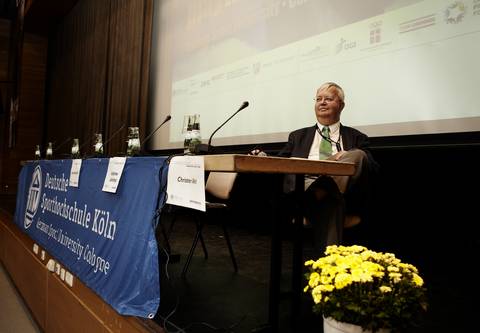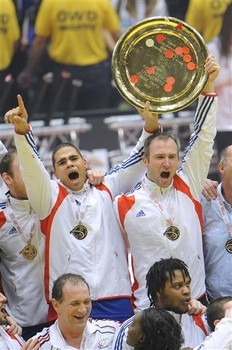
Unless there's a ground-breaking business plan, this may be the new salary for the head of USA Team Handball
The financial challenges that USA Team Handball (USATH) faces became even more telling this past week with a simple posting on the Federation website welcoming applications for new leadership. The short post indicated that both the General Manager (GM) and Technical Director (TD) positions had been filled on a volunteer basis (implying non-paid) since the first of August and that the current incumbents had been invited to reapply.
And based on the details in the job advertisements it looks like severe austerity measures are likely to continue and intensify. Here’s the key paragraph:
SALARY & BENEFITS: GM shall receive no annual base salary, benefits or expense reimbursement. GM may propose his compensation to the BOD (Board of Directors) as part of an overall business organizational plan, wherein GM shall only be eligible for salary if specifically earmarked for such purpose via Sales, Donations or other Revenues generated directly by GM.
A similar paragraph is also included in the TD advertisement.
Upon reading this my first reaction was did they just reinstate the BOD we had a few years ago? The same BOD that became so dysfunctional that the USOC eventually decided to decertify USA Team Handball as an NGB (National Governing Body). What are they thinking?
Last year, I previously addressed the GM salary in a posting that reviewed USATH’s IRS Form 990. The U.S. Government requires that all non-profits fill out a Form 990 as part of their justification for not being taxed. GM Steve Pastorino earned $100K in Fiscal Year (FY) 2008 and also received at least $100K in FY 2009. (We certainly could debate whether the GM has done a job worthy of that salary and on more than one occasion we’ve highlighted shortcoming as well as successes. But individual job performance is not the point of this commentary.) As I noted there were a number of ways to compare that salary with similar positions in other sport organizations. Depending on how you wanted to look at it, the compensation was either too much or too little. I think it’s perhaps a little on the high side, but it’s in the ballpark. Maybe a reduction was in order in light of the staff layoffs and decreased USOC support, but switching to unpaid volunteer?
Certainly, to my knowledge there is not another USOC NGB which has a volunteer heading its operations, but perhaps the BOD has decided what other USA NGB’s do doesn’t really matter. After all, the Canadian Federation receives virtually no funding and their National Teams are comparable to ours and their grass roots development is probably a little head of us. The Canadians are certainly “getting by”, so to speak. I’m guessing, however, that if the Canadians had our level of funding one of the very first things they’d do would be to provide some compensation to their volunteers so they can devote more time to their efforts.
I guess on the surface, one can make a business case argument along the lines of “Why should you get paid if the work you perform does not correlate to increased revenue? Your salary is just hurting the bottom line.” After all, this is how many businesses function, especially for the individuals at the top of the pyramid. You get paid for results to the bottom-line.
There are some fundamental problems with this “earn your way” philosophy:
1) A non-profit NGB is not a business, at least not in the traditional sense. Don’t get me wrong, a well run non-profit is still going to employ a lot of business principles and sound management practices, but by definition, a non-profit shouldn’t look at bottom profit as a primary consideration. In fact, there will likely be quite a few decisions where management will correctly decide to hurt the bottom line finances of the organization because it’s mission is deemed more important than minimizing expenditures and maximizing revenue.
2) A GM has many responsibilities, and seeking additional revenue for the Federation through donation and sales is just one of them. The job advertisement, itself, highlights these many other functions that also have to be performed. But tyng salary to bringing in the dough or you won’t get paid will surely mean that fundraising will take precedence over everything else. And for the TD position, the salary is actually being tied to something that is even listed as an essential function in the job description! Don’t get me wrong, I would like the GM and even the TD to work this area hard, but it shouldn’t be to the exclusion of everything else.
3) Bringing in revenue for a minor sport like Team Handball isn’t easy and certainly won’t be as simple as writing a business plan. With the current state of the economy fundraising and bringing additional revenue is now very challenging for pretty much every non-profit. Even well established sports are finding it tough to find sponsors as individuals and organizations tighten their belt. For a minor sport like Team Handball which will likely not qualify for the 2012 Olympics it’s going to continue to be even tougher. I’m sure some prospective candidates will come forward with some business plans highlighting great revenue streams from a variety of sources. After all, getting hired with a salary apparently depends on it! Anyone who’s followed the sport in this country (even for just a couple of years, BOD members) should really know better. I’m not saying it will never happen, but it’s going to take some time and some breakthrough events that finally result in the sport getting increased exposure and attention.
If the BOD fails to find someone with the “business plan” that knocks them out of the park they should really think twice, though, about selecting a volunteer GM. Herewith are some of the reasons why they might want to reconsider:
1) A volunteer GM will not be able to devote the requisite amount of time required to do the job right. In my opinion, it’s quite possible that USATH will be able to find a volunteer that can fulfill some of the duties inherent in the GM position. But unless there’s somebody out there that’s independently wealthy and doesn’t need to work a day job, they’ll be hard pressed to find the time to fulfill all of the duties.
2) A volunteer GM will not have the same credibility with outside players (USOC, IHF, etc) that a full time paid GM will have. Rightly or wrongly, the mere fact that the USATH has determined that it’s sufficient to have an “amateur” in charge will be viewed negatively by outside players. They will assess that the U.S. is not really serious about developing Team Handball and will be less inclined to support development here.
3) A volunteer GM is less accountable to the BOD. If a volunteer GM isn’t performing or isn’t properly focusing on the right priorities, the BOD will be pretty hamstrung in terms of corrective action. Anyone who’s worked with volunteers before knows the limits of how far they can be pushed. They tend to prefer to do the activities/work they like to do and sometimes they have to be incentivized to work the activities they don’t like. And attempts to coerce sometimes can be met with lackluster enthusiasm ore even abandonment as the volunteer find better things to do with their spare time. However, when someone is paid and their livelihood depends on that paycheck, they tend to be less malleable.
In closing, I sincerely hope that I’ve missed the boat here. For all we know there’s an up and comer GM out there writing the business plan that will lead our sport out of the wilderness. Or perhaps a dedicated and skilled handball devotee is filling out his lottery card at the local 7-11 and will soon need some volunteer activities to keep him busy around the house. Anything’s possible, of course, including the BOD backtracking on a misguided job posting.
THN (13 Feb 2010): USATH releases IRS documentation: First glimpse of budget numbers: https://teamhandballnews.com/2010/02/usath-releases-irs-documentation-first-glimpse-of-budget-numbers/
USATH (7 Sep 2011): USATH welcomes applications for new leadership: http://usateamhandball.org/news/2011/09/07/usath-welcomes-applications-for-new-leadership/44515
USATH (General Manager Job Posting): http://usngbjobs.teamworkonline.com/teamwork/r.cfm?i=38313


















